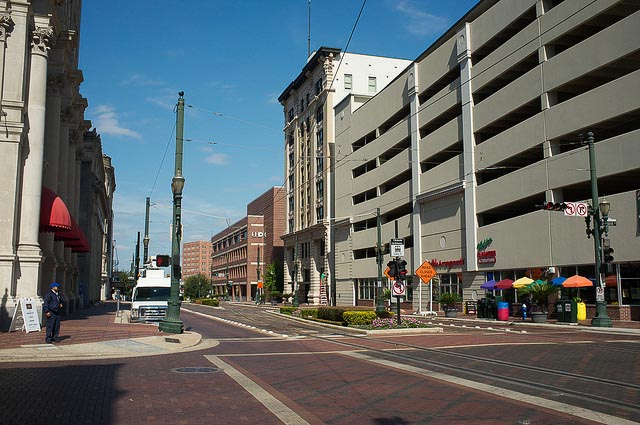When urban planner Jeff Speck visited Houston City Hall Wednesday, he was the first to admit just how intimidating his audience was.
Among those who turned out to hear the author and designer: Mayor Sylvester Turner, Comptroller Chris Brown (the city's number two elected official), heads of both the planning and public works departments, and more half a dozen city councilmembers.
Speck has delivered a variation of his speech on the value of walkability and the steps needed to achieve it many times. But never before, he acknowledged, had he been a room with so many policymakers from a major city who might be in a position to actually implement his advice.
"This is likely a new record for the gathering of public officials in a big city," Speck said at the event organized by the city's planning and development department.
Speck, author of the book Walkable City, was delivering his remarks in what might be an unlikely place: a city that is famously unwalkable. Houston has a walk score of 49 -- slightly lower than the national average among the city's largest cities -- and ranks 42nd among the country's largest cities for walkability.
But it's that ranking -- and a growing interest in improving it -- that's responsible for the reception he got from policymakers at City Hall. Many city leaders, including Turner himself, have an expressed a desire to promote walking and cycling alike in Houston.
Speck offered a familiar pitch: walkable communities promote health, reduce traffic deaths and are good for the economy. They also save lives. He described the city's approximate 283 traffic deaths annually as "a 9/11 every decade."
"It's a function of the way your city is designed," Speck said.
But he also offered concrete steps the city could take to improve walkability. In particular, he focused on downtown, where the city has a big asset: relatively small blocks that are only about 335 feet long, roughly comparable to those in downtown Portland, a famously walkable place. He offered six steps the city could take to make downtown more pedestrian-friendly.
Add more downtown housing. Houston, of course, has already made strides in this area, thanks in part to a program that subsidizes new downtown residential units. But the city still has a long way to go. Speck said downtown Houston has 8,000 downtown residential units (including existing units and those in the pipeline) compared to 144,000 downtown jobs. Most places strive to come as close to a 1:1 ratio as possible. "Honestly," Speck said, "this is still a very piddling number." He urged the city to take whatever steps it could to eliminate any impediments that hinder downtown residential development.
Shrink downtown streets and make them two-way. Speck said some downtown and Midtown streets that are four-lanes wide and one-way essentially function as highways, creating unsafe conditions for pedestrians and drivers alike. That's because the more lanes a street has, the more drivers focus on jockeying for position and finding the "fast lane" rather than on their surroundings. He cited the case of Vancouver, Wash, which found an economic benefit to transforming its one-way streets into two-way streets. Speck said there's evidence that so-called "road diets" can remove lanes and slow traffic speeds without reducing throughput. He advocated for some Houston roads to go from 12-foot lanes to 10-foot lanes, in large part because they promote slower driving speeds that result in a reduced likelihood of death in the event of collision.
Use cars to protect cyclists. A relatively easy way of protecting pedestrians and cyclists is to move the parking lane away from the curb and use parked cars as a barrier to protect a new cycling lane. A lane of parked cars also makes pedestrians walking on the street or sitting in cafes feel safer -- and thus more likely to walk.
Add more street trees. Some parts of Houston, like Rice Village, are known for having a robust canopy of trees. In downtown Houston, there are some street trees too, but Speck said large swaths of downtown are entirely without them. Adding more trees can make a street more aesthetically pleasing and help prevent flooding. Unfortunately, Speck said, "the best time to plant a tree is 20 years ago."
Hide the parking garages. Downtown is full of parking garages, which are visually uninteresting and create a boring view for pedestrians passing by. Houston -- and other cities -- can take a lessen from other parts of the world and figure out how to hide them by surrounding them with other buildings, Speck suggested. At a minimum, their walls can be covered with street art. The result: the parking garages will still exist, but their imposing (and monotonous) facades are broken up, resulting in a more pleasurable environment for pedestrians that's likely to encourage walking.
Get rid of the tunnels. This probably isn't going to happen. Nonetheless, in an interview with the Urban Edge, Speck acknowledged downtown Houston's tunnel system probably isn't helping to promote street-level vitality, since pedestrian activity is split between above- and below-ground. "Neither system has a critical mass because they're split in half," Speck said. He acknowledged that any effort to scrap Houston's tunnels would be politically fraught. But as an outsider, he said the answer is easy. "Fill them in with sand."

